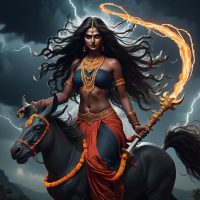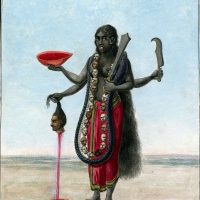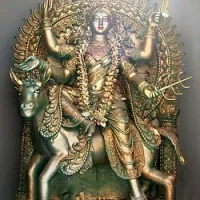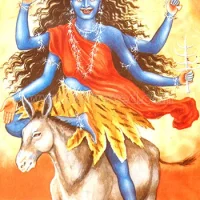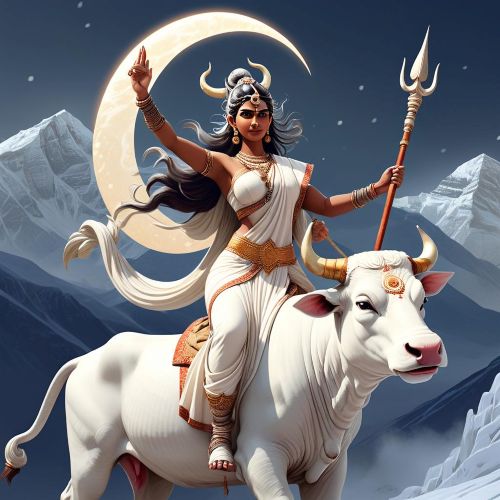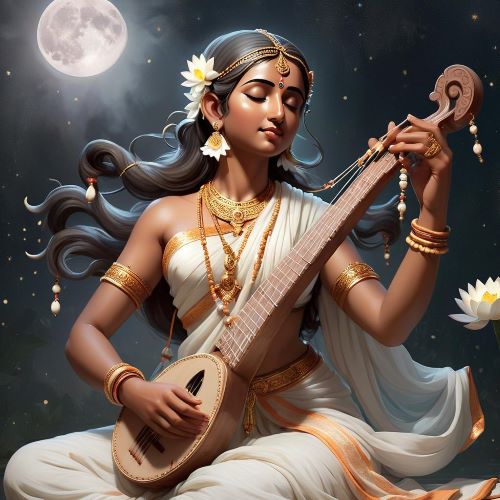Kalaratri : Goddess of Destruction
Listen
At a glance
| Description | |
|---|---|
| Origin | Indian Mythology |
| Classification | Gods |
| Family Members | Rudra (Husband) |
| Region | India |
| Associated With | Destruction, Rage |
Kalaratri
Introduction
Kalaratri, the seventh form of the Navadurga, is one of the most awe-inspiring manifestations of Goddess Durga. Her name combines “Kaal,” meaning time or death, with “Ratri,” meaning night, making her the embodiment of the “dark night of destruction.” This form of the Divine Mother symbolizes the inevitable dissolution of all that is unholy, while also guiding devotees toward spiritual awakening. Worshipped on the seventh day of Navratri, Kalaratri is revered not only for her terrifying power but also for her compassion in protecting her devotees from fear, ignorance, and evil. Ancient scriptures such as the Devi Mahatmya and the Mahabharata describe her role as a fierce defender of cosmic balance, annihilating demonic forces that threaten the world.
Physical Traits
Kalaratri is portrayed with an appearance that inspires both fear and reverence. Her complexion is dark, resembling the endless void of the cosmos, signifying dissolution and transcendence. Her hair flows wildly around her, reflecting untamed energy. With three blazing eyes, she sees beyond time and illusion, radiating fiery brilliance. Flames are often described as emanating from her breath, intensifying her fierce aura.
She is shown with four arms: in one she carries a curved sword, in another a thunderbolt or vajra, while the remaining two extend in gestures of protection (Abhaya Mudra) and blessing (Varada Mudra). These hand symbols assure devotees of safety and divine grace even in the midst of her terrifying form. She rides a donkey, an animal associated with endurance and humility, emphasizing that spiritual strength is not about pride but perseverance. Around her neck, she wears a garland of skulls or lightning, reinforcing her role as the destroyer of evil and illusion.
Family
Kalaratri is regarded as a fierce manifestation of Parvati, the consort of Lord Shiva. She represents the primal energy of the goddess when she sheds her gentle, nurturing form to confront demonic threats. Some traditions recount that Parvati assumed the form of Kalaratri to defeat the demons Shumbha, Nishumbha, and Raktabeej, forces that no other deity could vanquish.
She is also closely linked to Lord Shiva’s fierce aspect, Kala Bhairava, and is sometimes described as his consort. This connection highlights her role as both destroyer and protector, balancing Shiva’s cosmic power of dissolution. Within the broader family of the Navadurga, she stands as the seventh form, carrying forward the maternal mission of safeguarding creation while upholding justice.
Other Names
Kalaratri is celebrated under several names, each reflecting different facets of her personality and role in mythology. She is often called Shubankari, meaning “the auspicious one,” which reveals her benevolent side that blesses devotees with prosperity and peace. Another title, Bhayakarini, identifies her as the remover of fear, emphasizing her protective strength. She is also referred to as Raudri, representing her wrathful aspect, and Dhumorna, a name associated with smoke and dissolution found in Tantric texts.
Although she is sometimes compared to Kali, the two are not identical. Kali is a separate goddess with her own mythology, while Kalaratri remains a distinct manifestation within the Navadurga. Yet, their similarities—dark complexion, fierce imagery, and role in cosmic destruction—often lead devotees to revere them together.
Powers and Abilities
The powers of Kalaratri are vast, deeply symbolic, and tied to her role as the destroyer of evil. One of her most famous battles is against the demon Raktabeej. This asura had the boon that each drop of his blood falling on the ground would create another demon like him. Kalaratri consumed his blood before it could touch the earth, thus preventing his multiplication and ending his reign of terror. This story is more than a myth—it serves as a metaphor for overcoming recurring problems that seem impossible to conquer.
Her dominion extends beyond the battlefield. In spiritual traditions, Kalaratri is linked to the Sahasrara, or crown chakra, which represents enlightenment and union with the divine. Devotees believe she bestows supernatural powers (siddhis) and hidden treasures (nidhis) on those who worship her with sincerity. She also destroys ghosts, negative energies, and evil spirits, clearing the path for peace and clarity.
Her presence symbolizes time itself, for she is said to preside over death and dissolution at the end of cosmic cycles. This does not mark an end in despair but the beginning of renewal, where destruction clears space for new creation. Kalaratri’s destructive energy is purposeful, channeling chaos into transformation.
Modern Day Influences
Even in the modern age, Kalaratri continues to inspire millions. On the seventh night of Navratri, her worship remains a central ritual, where devotees offer prayers, chant mantras, and meditate to overcome fear and darkness within themselves. In some regions, households light lamps and recite hymns dedicated to her, while in others, community gatherings and cultural events keep her stories alive.
Beyond traditional worship, Kalaratri has found a place in contemporary interpretations of spirituality and culture. In Tantric practices, she is invoked for deep transformation and protection. Psychologically, she is seen as an archetype of the “dark mother,” a force that helps individuals confront their fears, trauma, and hidden shadows, pushing them toward personal growth. Feminist readings of mythology highlight her as a symbol of resilience and empowerment, showing how feminine energy can be both nurturing and ferociously protective.
Her influence also reaches into literature, art, and even digital media, where she is depicted as an icon of strength and defiance. Modern Indian cinema and artistic works often draw parallels between Kalaratri and contemporary women who embody fearlessness and determination. In many ways, her legend reminds people that true courage lies not in avoiding darkness but in facing it with unwavering strength.
Related Images
Source
Devi Dutta Shukra. (1920). Kalratri. Gandhi Pustak Mala Bhasndar Allahabad.
Indian Mythology Co. (2024, September 18). What is the story behind goddess Kalaratri? Retrieved from https://indianmythology.co.in/what-is-the-story-behind-goddess-kalaratri/
Rudraksha Ratna. (2025, September 16). Kaalratri Devi in Navratri 2025: Significance, Worship, Puja. Retrieved from https://www.rudraksha-ratna.com/articles/kalratri-devi
Drik Panchang. (n.d.). Goddess Kalaratri. Retrieved from https://www.drikpanchang.com/hindu-goddesses/parvati/durga/navdurga-kalaratri.html
Lovenspire Blog Corner. (2025, September 11). Navratri Day 7: Kalaratri, Dark Night Soul. Retrieved from https://lovenspire.com/blogs/lovenspire-blog-corner/navratri-day-7-kalaratri-dark-night-soul
Sadhana App. (2023, June 24). The Story of Ma Kalratri. Retrieved from https://sadhana.app/?p=2323
Wisdomlib.org. (2025, September 4). Kalaratri, Kala-ratri, Kālarātri. Retrieved from https://www.wisdomlib.org/definition/kalaratri
Chamunda Swamiji. (2025, April 2). Maa Kalaratri: Fierce Protector & Destroyer of Evil. Retrieved from https://www.chamundaswamiji.com/maa-kalaratri-fierce-protector-destroyer-of-evil/
Frequently Asked Questions
What is lorem Ipsum?
I am text block. Click edit button to change this text. Lorem ipsum dolor sit amet, consectetur adipiscing elit. Ut elit tellus, luctus nec ullamcorper mattis, pulvinar dapibus leo.
What is lorem Ipsum?
I am text block. Click edit button to change this text. Lorem ipsum dolor sit amet, consectetur adipiscing elit. Ut elit tellus, luctus nec ullamcorper mattis, pulvinar dapibus leo.
What is lorem Ipsum?
I am text block. Click edit button to change this text. Lorem ipsum dolor sit amet, consectetur adipiscing elit. Ut elit tellus, luctus nec ullamcorper mattis, pulvinar dapibus leo.
What is lorem Ipsum?
I am text block. Click edit button to change this text. Lorem ipsum dolor sit amet, consectetur adipiscing elit. Ut elit tellus, luctus nec ullamcorper mattis, pulvinar dapibus leo.
What is lorem Ipsum?
I am text block. Click edit button to change this text. Lorem ipsum dolor sit amet, consectetur adipiscing elit. Ut elit tellus, luctus nec ullamcorper mattis, pulvinar dapibus leo.


